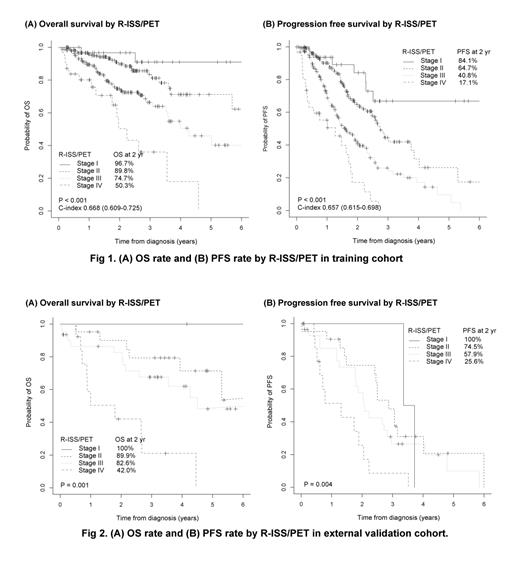Abstract
Background
A high number of focal lesions (FL) detected using PET/CT at diagnosis were found to be associated with adverse prognosis along with Revised International Staging System (R-ISS). In present study, we combined R-ISS with FL using PET/CT to design a reliable and easily applicable risk stratification system in patients with newly diagnosed MM (NDMM).
Methods
In training cohort, the data of 380 patients with NDMM who underwent 18F-fluorodeoxyglucose (18F-FDG) PET/CT upon diagnosis from 10 hospitals of the Korean Multiple Myeloma Working Party were retrospectively analyzed. All patients were classified by R-ISS and were treated by frontline therapy with proteasome inhibitors (PI) and/or immunomodulatory drugs (IMiD). The K-adaptive partitioning algorithm was adopted to develop the new risk groups with homogeneous survival. Sixty-seven patients in external validation cohort were additionally collected to confirm reproducibility of the new risk groups.
Results
In the training cohort, 199 patients (52.4%) showed FL > 3 using PET/CT at diagnosis. R-ISS stages I, II, and III were 78 patients (20.5%), 230 (60.5%), and 72 (18.9%), respectively. The combined R-ISS with PET/CT newly allocated NDMM patients into four groups: R-ISS/PET stage I (n=30; R-ISS I with FL≤3), stage II (n=149; R-ISS I with FL>3 and R-ISS II with FL≤3), stage III (n=166; R-ISS II with FL>3 and R-ISS III with FL≤3), and stage IV (n=35; R-ISS III with FL>3). The new R-ISS/PET showed significantly pronounced survival differences according to stages. Two-year overall survival (OS) rates were 96.6%, 89.5%, 75.0%, and 57.9% (p < 0.001), and 2-year progression-free survival (PFS) rates were 86.9%, 65.1%, 41.9%, and 15.2% (p < 0.001) in stages I, II, III, and IV, respectively. The prognostic role of the R-ISS/PET for survival outcomes was also confirmed in different subgroups classified by transplant eligibility and by types of treatments. In the external validation cohort, the new R-ISS/PET was successfully implemented. Two-year OS rates for were 100%, 89.9%, 82.6%, and 42.0% for R-ISS/PET I, II, III, and IV, respectively (p = 0.001). PFS rates at 2 years for each R-ISS/PET were 100%, 74.5%, 57.9%, and 25.6%, respectively (p = 0.004). In the multivariate Cox analysis for survival outcome, R-ISS/PET was a significant factor and could predict long-term outcomes with regard to OS: stage II vs. I (HR 2.50, p = 0.215), (ii) stage III vs. I (HR 5.11, p = 0.025), and (iii) stage IV vs. I (HR 10.3, p = 0.003) and PFS: (i) stage II vs. I (HR 2.21, p = 0.005), (ii) stage III vs. I (HR 4.57, p < 0.001), and (iii) stage IV vs. I (HR 9.48, p < 0.001).
Conclusion
The new R-ISS/PET had a remarkable prognostic power for estimating the survival outcomes of patients with NDMM. This system helps discriminate patients with a good prognosis from those with a poor prognosis more precisely. Thus, R-ISS/PET is applicable for identifying heterogeneous manifestation of clinical MM.
No relevant conflicts of interest to declare.


This feature is available to Subscribers Only
Sign In or Create an Account Close Modal